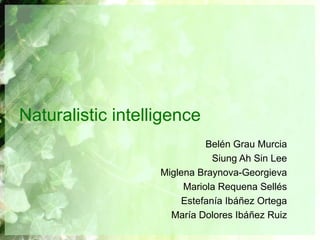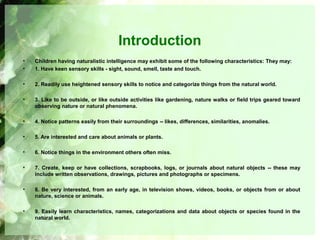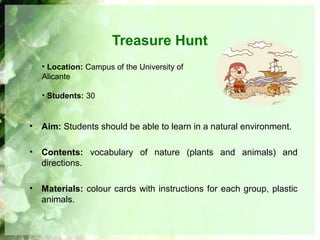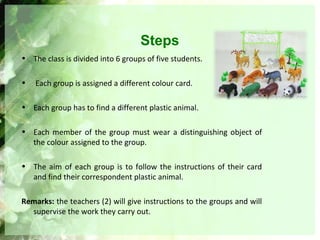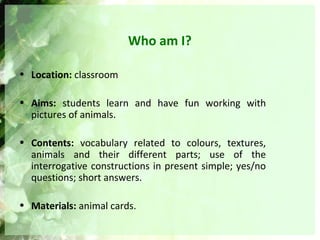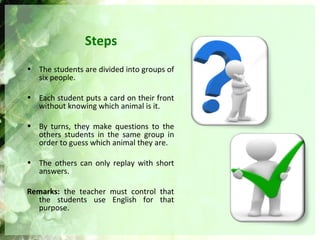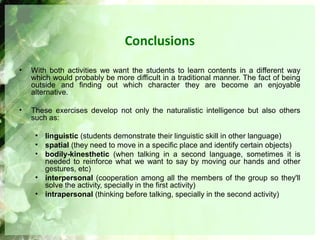Naturalistic intelligence
- 1. Naturalistic intelligence BelĂ©n Grau Murcia Siung Ah Sin Lee Miglena Braynova-Georgieva Mariola Requena SellĂ©s EstefanĂa Ibáñez Ortega MarĂa Dolores Ibáñez Ruiz
- 2. Introduction • Children having naturalistic intelligence may exhibit some of the following characteristics: They may: • 1. Have keen sensory skills - sight, sound, smell, taste and touch. • 2. Readily use heightened sensory skills to notice and categorize things from the natural world. • 3. Like to be outside, or like outside activities like gardening, nature walks or field trips geared toward observing nature or natural phenomena. • 4. Notice patterns easily from their surroundings -- likes, differences, similarities, anomalies. • 5. Are interested and care about animals or plants. • 6. Notice things in the environment others often miss. • 7. Create, keep or have collections, scrapbooks, logs, or journals about natural objects -- these may include written observations, drawings, pictures and photographs or specimens. • 8. Be very interested, from an early age, in television shows, videos, books, or objects from or about nature, science or animals. • 9. Easily learn characteristics, names, categorizations and data about objects or species found in the natural world.
- 3. Treasure Hunt • Aim: Students should be able to learn in a natural environment. • Contents: vocabulary of nature (plants and animals) and directions. • Materials: colour cards with instructions for each group, plastic animals. • Location: Campus of the University of Alicante • Students: 30
- 4. Steps • The class is divided into 6 groups of five students. • Each group is assigned a different colour card. • Each group has to find a different plastic animal. • Each member of the group must wear a distinguishing object of the colour assigned to the group. • The aim of each group is to follow the instructions of their card and find their correspondent plastic animal. Remarks: the teachers (2) will give instructions to the groups and will supervise the work they carry out.
- 5. Who am I? • Location: classroom • Aims: students learn and have fun working with pictures of animals. • Contents: vocabulary related to colours, textures, animals and their different parts; use of the interrogative constructions in present simple; yes/no questions; short answers. • Materials: animal cards.
- 6. Steps • The students are divided into groups of six people. • Each student puts a card on their front without knowing which animal is it. • By turns, they make questions to the others students in the same group in order to guess which animal they are. • The others can only replay with short answers. Remarks: the teacher must control that the students use English for that purpose.
- 7. Conclusions • With both activities we want the students to learn contents in a different way which would probably be more difficult in a traditional manner. The fact of being outside and finding out which character they are become an enjoyable alternative. • These exercises develop not only the naturalistic intelligence but also others such as: • linguistic (students demonstrate their linguistic skill in other language) • spatial (they need to move in a specific place and identify certain objects) • bodily-kinesthetic (when talking in a second language, sometimes it is needed to reinforce what we want to say by moving our hands and other gestures, etc) • interpersonal (cooperation among all the members of the group so they'll solve the activity, specially in the first activity) • intrapersonal (thinking before talking, specially in the second activity)
